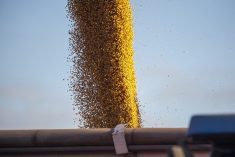Chicago | Reuters—Chicago soybean and corn futures surged on Thursday on short covering and bargain buying after prices sank low enough to attract buying interest, though supply pressure from favorable U.S. crop conditions continue to loom over the market, analysts said.
Wheat futures spent the session seesawing, but received underlying spillover support from corn futures.
“The market sold off all summer long, but you’re seeing some really good export numbers; it was a matter of time before the market found itself a bottom,” Jon Marcus, principal owner of Lakefront Futures, said.
Read Also

U.S. livestock: Feeder cattle hit contract highs on tight supply
Chicago | Reuters – All Chicago Mercantile Exchange feeder cattle futures and most live cattle futures hit contract highs on…
The most-active soybean contract on the Chicago Board of Trade Sv1 settled 20 cents higher to $10.56 per bushel. CBOT corn Cv1 ended 7-3/4 cents higher at $4.11-3/4 per bushel, with brisk export demand supporting a recovery from contract lows hit last week.
Grain markets were awaiting a demand update from weekly U.S. export sales later on Thursday and further results from Pro Farmer’s annual crop tour through the U.S. Midwest.
Third-day results from the Pro Farmer crop tour showed Illinois has its highest soybean pod counts in at least 22 years and its second-highest corn yield potential.
Western Iowa showed above-average yield prospects, though crop diseases could threaten final yields.
The annual tour, running through Thursday, is closely followed by the grain market and especially scrutinized this year after the U.S. Department of Agriculture projected a much larger-than-expected 2025 corn crop.
CBOT wheat Wv1 settled 1-1/2 cents higher at $5.29-3/4 per bushel in a bounce off contract lows set on Wednesday.
Wheat markets have been weighed down by expectations of ample global supply, including rising estimates of Russia’s harvest, though slow Russian exports and demand from Egypt and other importers have helped underpin the market.
— Additional reporting by Gus Trompiz in Paris and Ella Cao and Lewis Jackson in Beijing.















